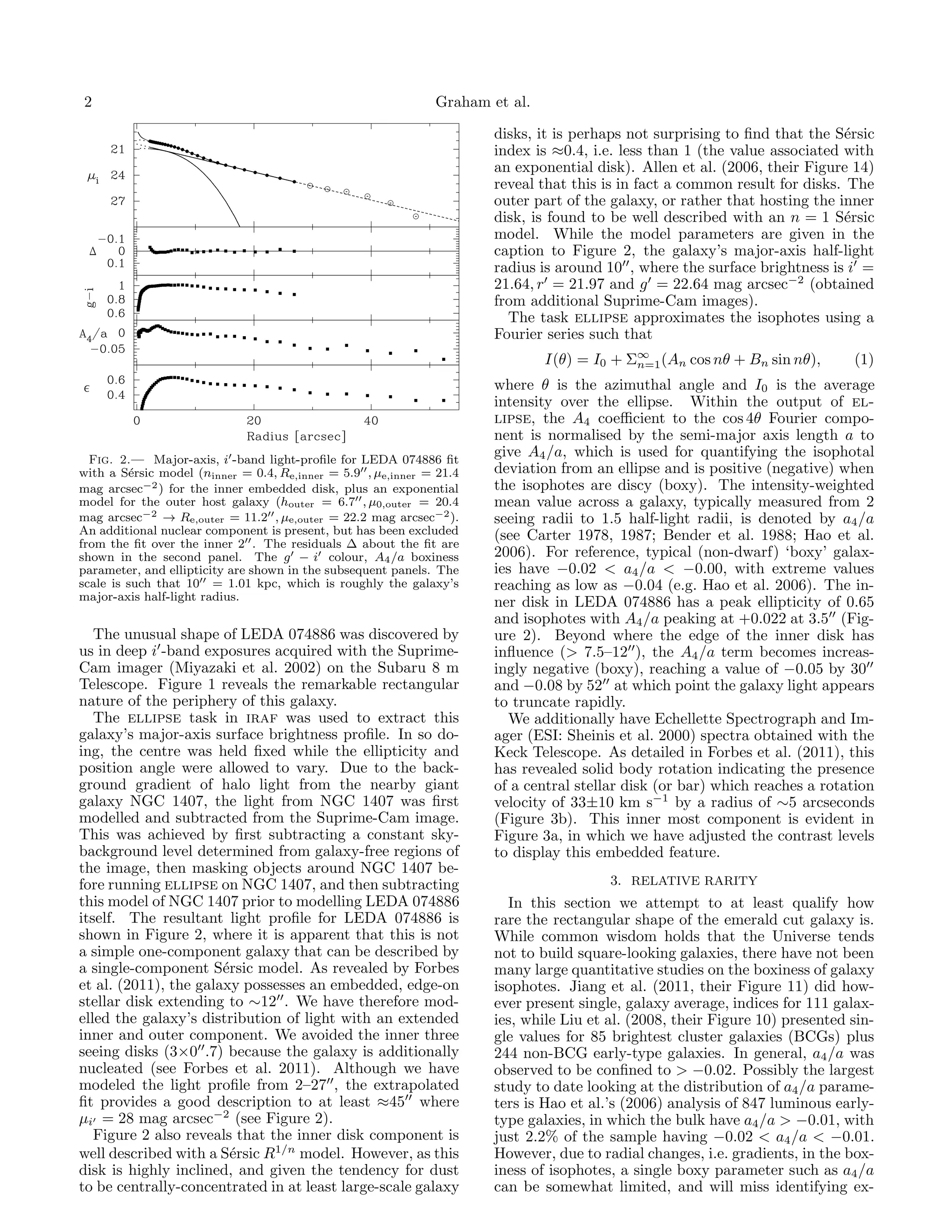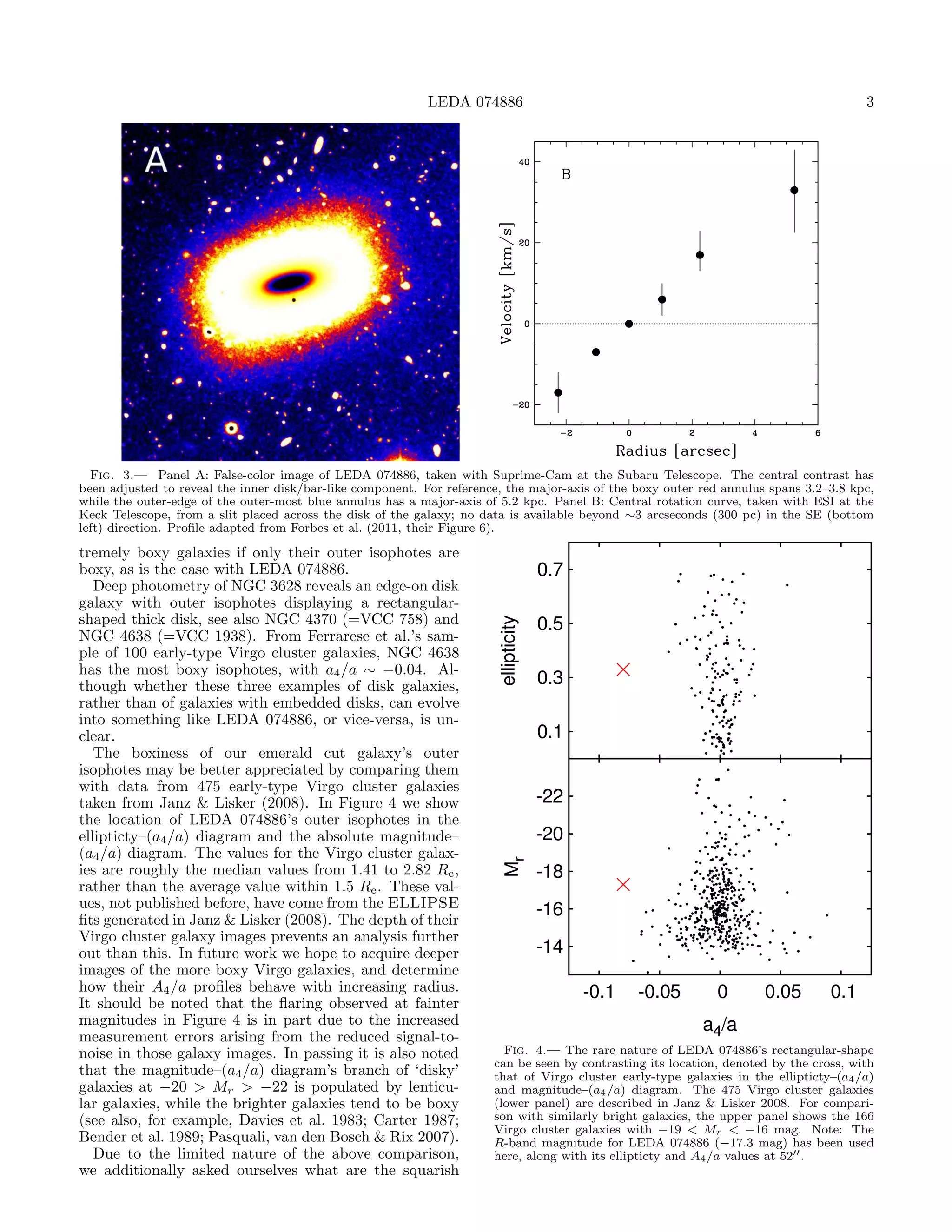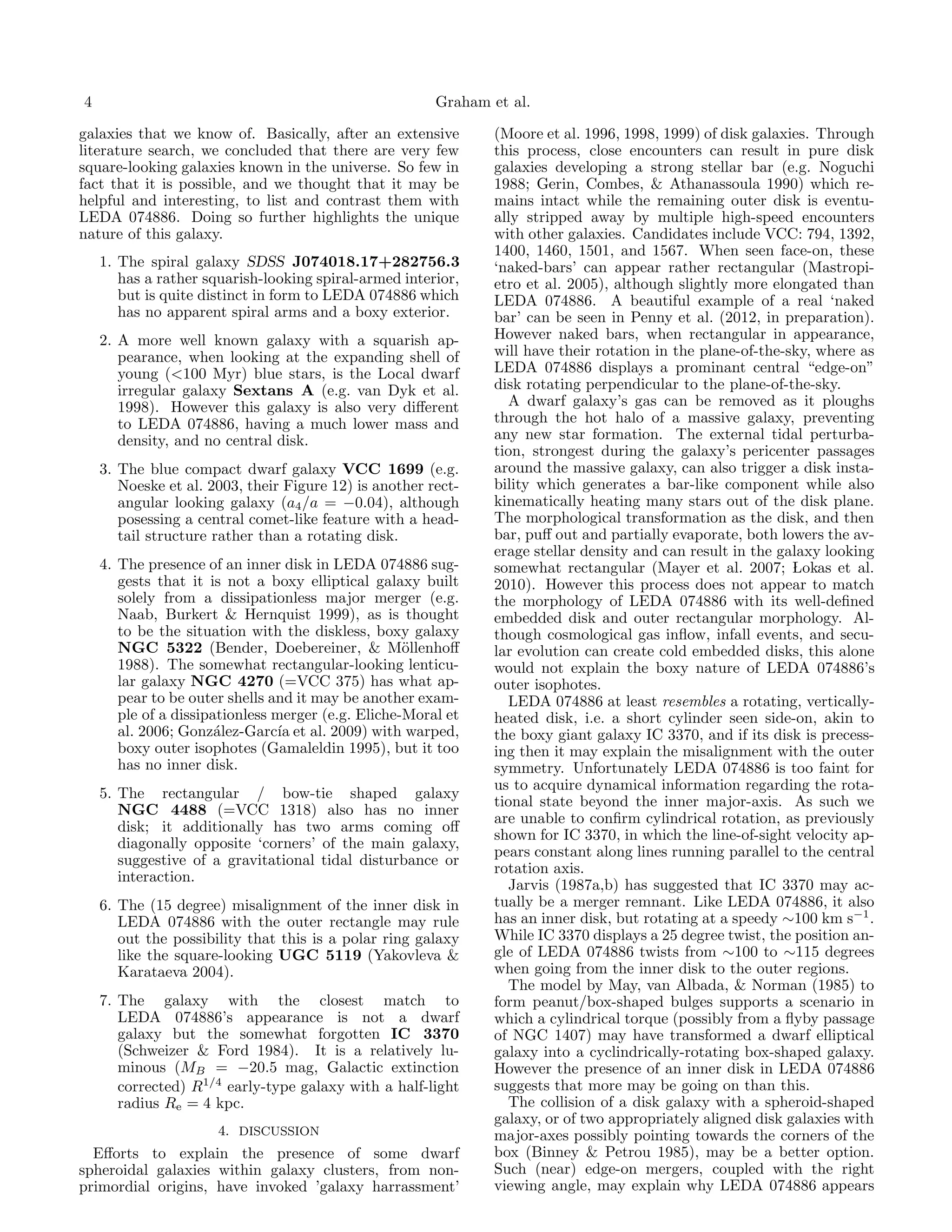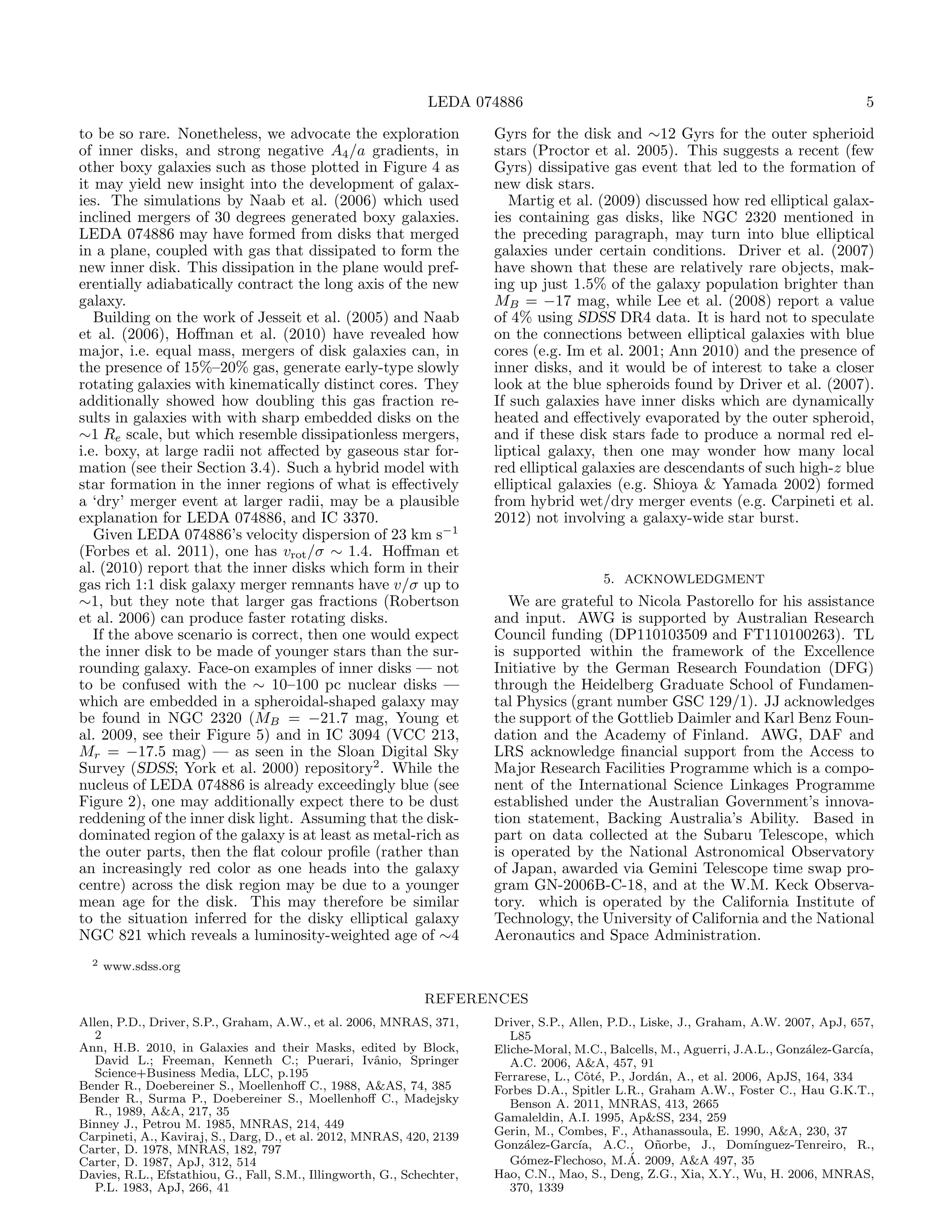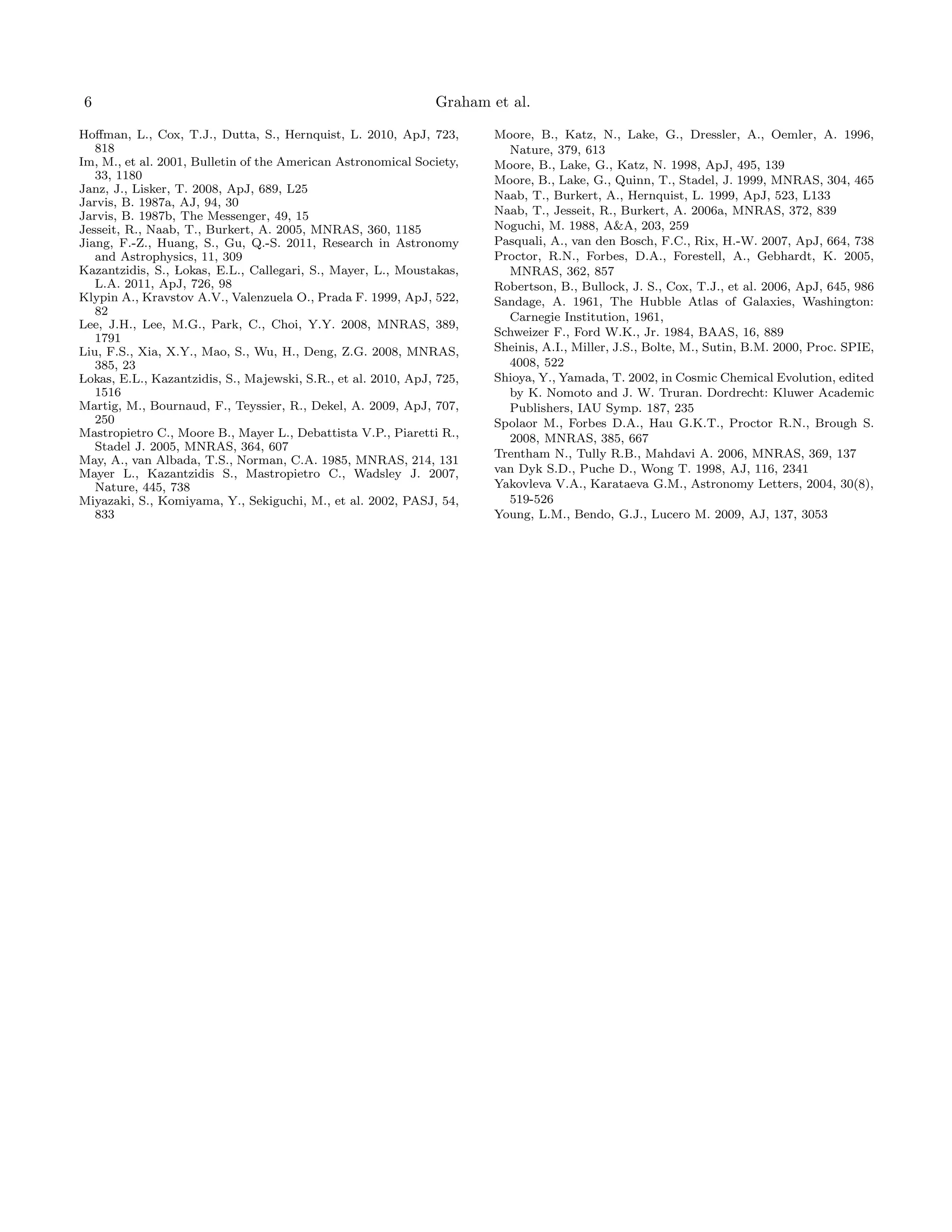This document describes the discovery of an unusual rectangular-shaped galaxy called LEDA 074886. Some key details:
- LEDA 074886 has an absolute magnitude of -17.3 and resembles an "emerald cut diamond" in shape with very boxy isophotes.
- It contains an embedded edge-on stellar disk of extent 1.2 kpc, with a rotation to dispersion ratio of 1.4.
- The authors speculate that LEDA 074886 may be the remnant of two merged disk galaxies, where the initial gas drove inward to form the inner disk, while the stars at larger radii experienced a dissipationless merger resulting in the rectangular shape.
-
![Draft version March 19, 2012
Preprint typeset using L TEX style emulateapj v. 03/07/07
A
LEDA 074886: A REMARKABLE RECTANGULAR-LOOKING GALAXY
Alister W. Graham1 , Lee R. Spitler, Duncan A. Forbes
Centre for Astrophysics and Supercomputing, Swinburne University of Technology, Hawthorn, Victoria 3122, Australia.
Thorsten Lisker
arXiv:1203.3608v1 [astro-ph.CO] 16 Mar 2012
Astronomisches Rechen-Institut, Zentrum fr Astronomie der Universitt Heidelberg, Mnchhofstrae 12-14, 69120 Heidelberg, Germany.
Ben Moore
Institute for Theoretical Physics, University of Zurich, Zurich, Switzerland.
Joachim Janz
Division of Astronomy, Department of Physics, University of Oulu, P.O. Box 3000, FI-90014 Oulun Yliopisto, Finland. and
Astronomisches Rechen-Institut, Zentrum fr Astronomie der Universitt Heidelberg, Mnchhofstrae 12-14, 69120 Heidelberg, Germany.
Draft version March 19, 2012
ABSTRACT
We report the discovery of an interesting and rare, rectangular-shaped galaxy. At a distance of 21
Mpc, the dwarf galaxy LEDA 074886 has an absolute R-band magnitude of −17.3 mag. Adding to this
galaxy’s intrigue is the presence of an embedded, edge-on stellar disk (of extent 2Re,disk = 12′′ = 1.2
kpc) for which Forbes et al. reported vrot /σ ≈ 1.4. We speculate that this galaxy may be the remnant of
two (nearly edge-one) merged disk galaxies in which the initial gas was driven inward and subsequently
formed the inner disk, while the stars at larger radii effectively experienced a dissipationless merger
event resulting in this ‘emerald cut galaxy’ having very boxy isophotes with a4 /a = −0.05 to −0.08
from 3 to 5 kpc. This galaxy suggests that knowledge from simulations of both ‘wet’ and ‘dry’ galaxy
mergers may need to be combined to properly understand the various paths that galaxy evolution can
take, with a particular relevance to blue elliptical galaxies.
Subject headings: galaxies: formation — galaxies: individual (LEDA 074886) — galaxies: kinematics
and dynamics — galaxies: peculiar — galaxies: structure
1. INTRODUCTION
In the universe around us, the overwhelming major-
ity of bright galaxies exist in one of three main forms
(Sandage 1961). Many, including our own Milky Way
galaxy, are in the shape of a flattened circular disk, typi-
cally hosting a spiral pattern of stars and a central bulge.
A significant number of galaxies are shaped something
like an ellipsoidal football, while the remaining few are
lumpy and irregular in appearance. Pushing into the
dwarf galaxy regime, while many elliptical and lenticu-
lar dwarf galaxies exist, the spiral galaxies tend to give
way to more irregular looking galaxies without a clear
symmetry or form.
We have discovered an exceedingly rare example of a
rectangular-shaped galaxy, which may be unique for its
luminosity. LEDA 074886 (α = 03h 40m 43.2s, δ = -18d
38m 43s: J2000) resides within the hot gas halo of the
massive, spherical galaxy NGC 1407 (E0), with a pro-
jected separation of ∼50 kpc from this giant galaxy’s
core. LEDA 074886, which we affectionately call the Fig. 1.— A 120×120 arcsecond (∼12×12 kpc) i-band image of
“emerald cut galaxy” given its striking resemblance to an LEDA 074886. North is up and East is left. NGC 1407 is located
∼50 kpc to the NW.
emerald cut diamond, is the 25th brightest galaxy within
the NGC 1407 Group of over 250 galaxies (Trentham,
Tully, & Mahdavi 2006). At a distance of 21 Mpc (Spolaor et al. 2008),
LEDA 074886 has an apparent (and absolute) R-band
brightness of 14.3 (and -17.3) mag (Trentham et al.
2. DATA AND ANALYSIS 2006), roughly corresponding to a stellar mass of 109 M⊙
(see Forbes et al. 2011, their section 9.1). The associated
1 Corresponding Author: AGraham@astro.swin.edu.au spatial scale is such that 1′′ = 101 pc.](https://image.slidesharecdn.com/retangulargalaxy-120319234412-phpapp02/75/Retangular-galaxy-1-2048.jpg)
